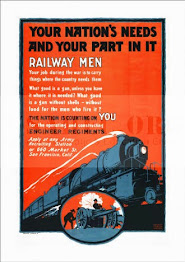723rd Railway Operating Battalion Roster by Nancy Cunningham
723rd Railway Operating Battalion Roster
Tuesday, March 16, 2010 | Labels: 723rd Railway Operating Battalion, roster | 0 Comments
US Army 101 ( #101) Locomotive
History of the 101
The history of the 101 is something of a mystery. What we do know is that it was built for the US Army for use in World War I by Baldwin Locomotive Works. It was owned by the US Army until it was donated to Korea to help fight for Korea's freedom.In 1953, the 101 was recovered from damaged areas and reconstructed by the Army Transportation Corps., under the direction of Col. George Simpson. It seems that the 101 was still property of the Korean Republic however. Col. George Simpson, Harold T.I. Shannon, and Harold E. Fuller started to talk with the Korean Republic about donating the engine to the National Railroad Museum.
In 1958 Korean Republic President Syngman Rhee donated the locomotive as a gift from the Korean people. Over 300 newspapers carried the story of the arrival of the engine and this is how the struggling National Railroad Museum started to gain national attention. On May 30, 1959, General Pershing was presented with a Certificate of Service from the United states Army. The certificate was presented to the Museum by the Secretary of the Army.
Any other information this is to be found on the Internet or in print is suspicious at best. There are at least three different versions of the history of the 101 floating around.
History according the National Railroad Museum
According the National Railroad Museum Highlight and Data Catalog, the General Pershing saw action in France in 1918, Army camps in World War II, and was sent to Korea in 1951. (National Railroad Museum - Highlight and Data Catalog, p. 14)History according to David P. Morgan
David P. Morgan wrote and article for the June 1959 issue of Trains magazine. In it he says "On July 18, 1917, the U. S. Government ordered 150 2-8-0's from the Baldwin Locomotive Works for service in France. The first engine was delivered just 20 days later, since the design virtually duplicated (except for its superheater) that of the Consolidations Baldwin was building for the British War Office. The 150th engine got only as far as Norfolk, Va., where it was reassigned as a switcher to Fortress Monroe. In 1925 the Army overhauled the stay-at-home, named her the General Pershing, and kept her at work on local bases. During World War II the Pershing chuffed about Army camps in the South. Finally in 1947 she and 100 World War II surplus Army engines were donated to the Republic of Korea. When the Korean conflict broke out the veteran 2-8-0 was switching at Pusan. She soon saw combat, won fame as "the darling of the Military Railway Service." In January 1959 she came home, a gift of Korean President Rhee to the Green Bay (Wis.) National Railroad Museum. So some old engines, like old military men, do not fade away." (Trains Magazine)Chronology
As best as can be figured out, this is the history of the General Pershing.- 1917 - Built
- 1919-1937 - Ft. Monroe, Norfolk Army Base
- 1925 - Modernized and new cab
- 1940 - Modernized and new cab
- 1942 - Wreck en route to Camp Blanding Florida from Ft. Benning, Georgia
- 1945 - Storage
- 1947 - Shipped to Korea
- 1959 - Shipped to National Railroad Museum
Numbers the General Pershing carried
As best as can be figured out, this is the numbering history of the General Pershing.- 8341 - Utility Railroad Service
- 6779 - upon arrival in Korea
- 765 - After the 765th Transportation Shop Bn. rebuilt it.
- 101 - Korean National Railways
Surviving Pershing Class Locomotives
- US Army No. 101
- Texas State Railroad No. 300
References
- Unknown Author(s) (Unknown Year after July, 1973). "National Railroad Museum - Highlight and Data Catalog", Castle-Pierce Press.
- Albert Carpenter Kalmbach, ed. (1959). "Trains Magazine", Kalmbach Publishing Co.
- http://en.wikipedia.org/wiki/United_States_Army_No._101
Tuesday, March 16, 2010 | Labels: locomotives | 0 Comments
Allied Military Locomotives of the Second World War
During the Second World War, many interesting types of locomotives, both steam and diesel, were built for the British War Department and the United States Army Transportation Corps. These were sent all over the world and many of them remained in service long after the war, sometimes with their exact origin forgotten.
In this book, after some 50 years of research into matters generally held secret at the time, the overall story is presented. It starts in the first Section with general descriptions of the campaigns in the different theatres of war from a railway viewpoint, and then follows in the second and third Sections with Chapters giving the class histories of the various British and American types of locomotives, both Sections starting with a numerical list of the locomotives which give the key to the WD and USA/TC numbering structure. Finally, there are some Chapters dealing with odd topics such as various important military railways.
Contains 372 photographs, 43 drawings and 27 maps as well as many stock lists. See the Table of Contents.
Note that this book includes the content of the out-of-print books United States Army Transportation Corps Locomotives (ISBN-13 978-0-905878-01-0; ISBN-10 0-905878-01-9) and War Department Locomotives (ISBN-13 978-0-905878-00-3; ISBN-10 0-905878-00-0).
Tuesday, March 16, 2010 | Labels: book, locomotives, World War II pt 1 | 0 Comments
765th TRSB ( Transportation Railway Shop Battalion, ) in Korea- Capt. Bill Griffin
Tuesday, March 16, 2010 | Labels: 765th Transportation Railway Shop Battalion | 0 Comments
726th V -Mail ( Victory Mail)
V-mail stands for Victory Mail. It was based on the similar British "Airgraph" system for delivering mail between those at home in the United States and troops serving abroad during World War II. V-mail correspondence worked by photographing large amounts of censored mail reduced to thumb-nail size onto reels of microfilm, which weighed much less than the original would have. The film reels were shipped by priority air freight (when possible) to the US, sent to prescribed destinations for enlarging at a receiving station near the recipient, and printed out on lightweight photo paper. These facsimiles of the letter-sheets were reproduced about one-quarter the original size and the miniature mail was delivered to the addressee.
 V-mail used standardized stationary, 7 by 9 1/8 inches (17.8 cm by 23.2cm) with a glue flange on one side so that the letter could be folded and sealed in such a way as to become its own envelope. When used by overseas servicemen the letters were opened, censored and photographed. Only the film negatives were transported. After transport by air, reduced-sized versions of the letters were printed from the negatives for delivery to their final destinations. These 60%-reduced photocopies measured 4 1/4 by 5 3/16 inches (10.7cm x 13.2cm), and had a pre-formed crease 1 7/8 inches from the top. The crease insured that the address would be correctly centered behind an opening in a special envelope. The user would write the message in the prescribed space—ideally in black ink, since this photographed best (the Carter ink company marketed a special "V-Mail Ink")— fold the letter/envelope form, address it, affix postage and then the mail was on its way.
V-mail used standardized stationary, 7 by 9 1/8 inches (17.8 cm by 23.2cm) with a glue flange on one side so that the letter could be folded and sealed in such a way as to become its own envelope. When used by overseas servicemen the letters were opened, censored and photographed. Only the film negatives were transported. After transport by air, reduced-sized versions of the letters were printed from the negatives for delivery to their final destinations. These 60%-reduced photocopies measured 4 1/4 by 5 3/16 inches (10.7cm x 13.2cm), and had a pre-formed crease 1 7/8 inches from the top. The crease insured that the address would be correctly centered behind an opening in a special envelope. The user would write the message in the prescribed space—ideally in black ink, since this photographed best (the Carter ink company marketed a special "V-Mail Ink")— fold the letter/envelope form, address it, affix postage and then the mail was on its way.According to the National Postal Museum, "V-mail ensured that thousands of tons of shipping space could be reserved for war materials. The 37 mail bags required to carry 150,000 one-page letters could be replaced by a single mail sack. The weight of that same amount of mail was reduced dramatically from 2,575 pounds to a mere 45." This saved considerable weight and bulk in a time in which both were hard to manage in a theatre of the war. It also eliminated the threat of spies using microdots or invisible ink to send reports. Any microdot would not be photographed with enough resolution to be read.
Although the system of V-mail ensured that more pieces of mail were able to be shipped and delivered than a larger, bulkier mailing would have accomplished, many people found that they did not have enough room in the limited available space in order to write all that they had to say. To make things worse, the instructions at the top of each letter stated that "very small writing is not suitable".
http://en.wikipedia.org/wiki/V-mail
Tuesday, March 16, 2010 | Labels: 726th Railway Operating Battalion, V -Mail (Victory Mail), World War II pt 1 | 0 Comments
791st Railway Operating Battalion -Simms
Tuesday, March 16, 2010 | Labels: 791st Transportation Battalion | 0 Comments
741st Army Railroad Training to Begin
Tuesday, March 16, 2010 | Labels: 741st Railway Operating Battalion | 0 Comments
712th News Supply Forces
Tuesday, March 16, 2010 | Labels: 712th Railway Operating Battalion | 0 Comments
765th ROB and 3rd Honors Wittekind
Tuesday, March 16, 2010 | Labels: 3rd TMRS, 765th Transportation Railway Shop Battalion | 0 Comments









